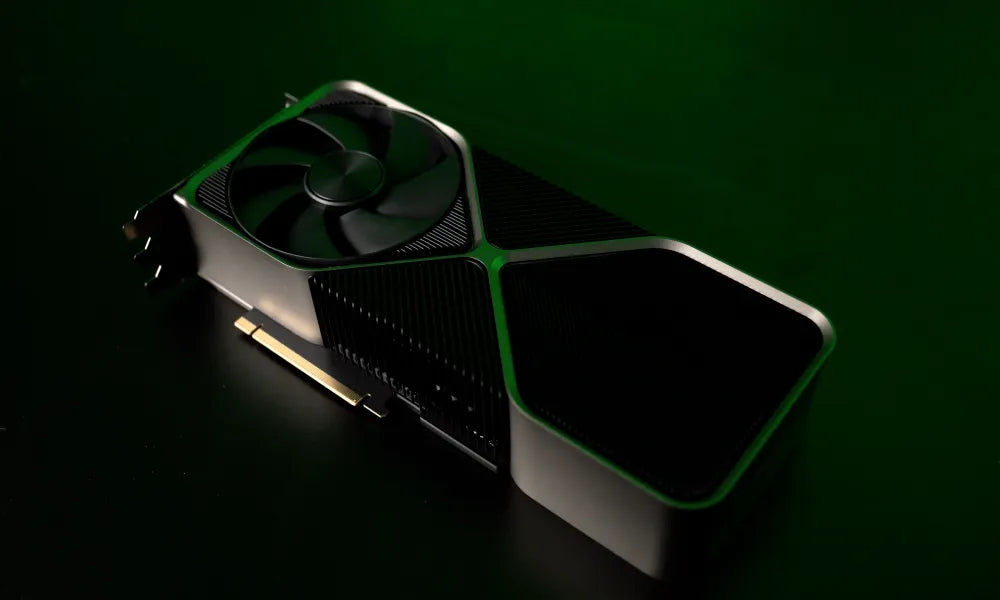
Nvidia RTX 50-Series GPUs: A Comprehensive Look at Rumors, Leaks, and Expectations
Share
Nvidia RTX 50-Series GPUs: A Comprehensive Look at Rumors, Leaks, and Expectations
The upcoming Nvidia RTX 50-series GPUs have become one of the most discussed tech topics, with speculation fueled by a steady stream of leaks and rumors. Nvidia's upcoming keynote at CES 2025 promises to shed light on the future of PC graphics, but until then, here’s a deep dive into everything we know so far—from mobile GPU sightings to potential desktop performance breakthroughs and architectural changes.
A New Era for Nvidia GPUs
Recent leaks from the PCI ID repository, promotional material, and even company slip-ups suggest that Nvidia’s Blackwell architecture is set to debut in both desktop and laptop GPUs very soon. One particularly intriguing teaser came from an Nvidia LAN 50 event promo where a shadowy PC housed what appears to be a brand-new GPU design. When brightened, the image revealed:
- A dual-front fan setup rather than the traditional push/pull design.
- An angled connector or cable adaptor, which is unusual for Nvidia’s GPUs.
- A sleek LED strip embedded in the design.
While this could be an early look at the RTX 5080 or RTX 5070, the card’s relatively compact size suggests it is likely not the RTX 5090.
Mobile Blackwell GPUs: PCI ID Leak
The PCI ID repository listed several Max-Q mobile GPUs—optimized for power-efficient laptops—under the RTX 5000 series:
- RTX 5090 Max-Q (GB203M)
- RTX 5080 Max-Q (GB203M)
- RTX 5070 Ti Max-Q (AD108M)
- RTX 5070 Max-Q (AD108M)
- RTX 5060 Max-Q (AD108M)
- RTX 5050 Max-Q (AD108M)
The standout observation is the use of AD108M chips, a leftover from the Lovelace architecture, in GPUs below the RTX 5080 tier. This raised eyebrows since these are older-generation chips, potentially suggesting either an internal error or a strategic move by Nvidia to differentiate the mid-tier lineup.
Desktop GPU Launch Schedule: RTX 5090 vs. RTX 5080
Rumors suggest that Nvidia will deviate from its typical launch pattern. Instead of starting with the flagship RTX 5090, it may launch the RTX 5080 first—potentially as soon as mid-January 2025, following the CES keynote. The RTX 5090 is expected to follow soon after, either by the end of January or early February.
According to insiders, Nvidia is reportedly discontinuing its RTX 40-series GPUs, apart from the entry-level RTX 4050 and RTX 4060 models, to make way for the RTX 50-series. This aligns with reports that popular high-end cards like the RTX 4080 have already become scarce, with rising prices indicating limited stock.
Specs and Performance Predictions
The Blackwell architecture, named after the mathematician David Blackwell, represents Nvidia’s next step in graphics innovation. Here’s what leaked data suggests about the RTX 50-series:
| GPU | CUDA Cores | Memory Type | Bus Width | VRAM | Bandwidth | TDP |
|---|---|---|---|---|---|---|
| RTX 5090 | 21,760 | GDDR7 | 512-bit | 32GB | 1.8TB/s | 550W |
| RTX 5080 | 10,752 | GDDR7 | 256-bit | 16GB | 896GB/s | 300W |
| RTX 5070 Ti | 8,960 | GDDR7 | 256-bit | 16GB | 896GB/s | 300W |
| RTX 5070 | 6,144 | GDDR7 | 192-bit | 12GB | 672GB/s | 250W |
| RTX 5060 | 4,608 | GDDR7 | 128-bit | 8GB | 448GB/s | TBD |
- Memory Innovation: GDDR7 memory is expected to deliver a 30% performance increase over GDDR6, making it ideal for next-gen workloads, including path tracing and AI-powered enhancements.
- Ray Tracing and Path Tracing: Nvidia is rumored to introduce a 2.5x boost in ray tracing performance.
Pricing Concerns and AI Influence
GPU pricing remains a significant point of speculation, with reports ranging from $1,200 for the RTX 5080 to as much as $2,500 for the RTX 5090. Nvidia’s focus on AI-driven GPU performance could keep demand—and prices—high. For example, early pre-built systems featuring the RTX 5090 have been spotted with price tags over $6,000.
Desktop vs. Laptop GPUs
Leaks from Clevo, a Taiwanese laptop manufacturer, confirmed that the mobile versions of the RTX 50-series will include:
- 16GB of VRAM for high-end GPUs like the RTX 5080 and RTX 5090.
- 8GB of VRAM for entry-level models like the RTX 5070 and below.
Mobile GPUs are expected to have lower TDPs (ranging from 140W to 175W) but may offer comparable performance to desktop models at reduced power draw.
Architecture and Power Draw
The desktop Blackwell lineup may still use Nvidia’s controversial 12VHPWR connectors, despite concerns over their reliability in the RTX 40-series. Some sources even suggest that the flagship RTX 5090 could have a TDP of 600W, though others believe it will stick closer to 500W.
One key improvement hinted at in leaks is an advanced cooling system, potentially reducing the need for massive four-slot designs like those seen in the RTX 4090.
What to Expect at CES 2025
Nvidia’s CES 2025 keynote is set for January 6, where the official reveal of the RTX 50-series is highly anticipated. This announcement could include both desktop and mobile GPUs, alongside potential surprises like a Titan AI GPU rumored to unlock the full power of the GB202 chip.
With AMD reportedly stepping back from the high-end GPU market, Nvidia seems poised to dominate the next generation of PC graphics cards. However, pricing and power efficiency will be critical factors in determining the reception of the RTX 50-series.
Final Thoughts
The Nvidia RTX 50-series promises significant advancements in gaming and professional workloads, with rumors pointing to groundbreaking performance increases. Whether you're an enthusiast planning your next gaming build or a professional seeking cutting-edge AI performance, the RTX 50-series is shaping up to be one of the most exciting GPU launches in years.
Stay tuned for more updates as we get closer to CES 2025—the future of PC gaming and graphics is almost here!
